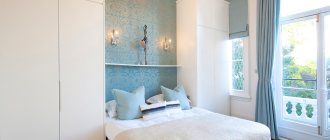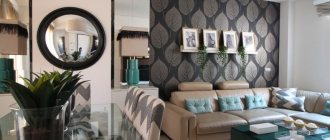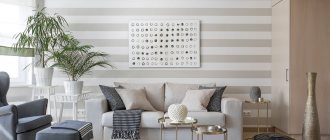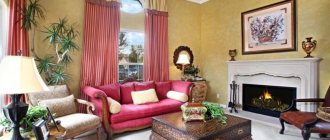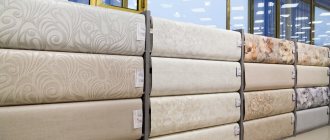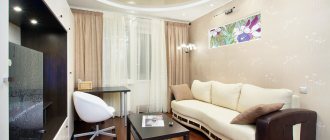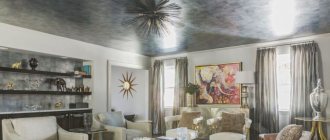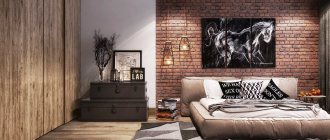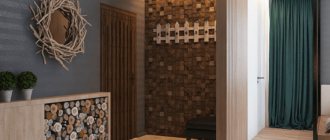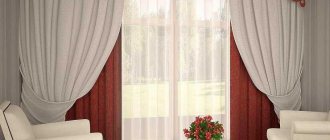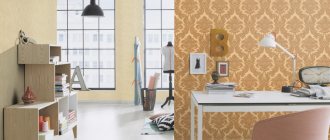Wallpaper companions for the hall
A stylish combination of multi-colored textured canvases helps to create an extraordinary living room design. New and unexpected combinations of wallpaper when decorating walls can not only emphasize the style of the interior, but also visually change the geometry of any room (corridor, hall, bedroom, bathroom).
One color scheme - different pattern or texture
This method of decorating a living room can be considered the simplest. However, before choosing wallpaper companions for the room, you have to take into account the style of the interior:
- canvases that imitate rough, untreated surfaces fit organically into modern interiors. Living rooms with an industrial touch are characterized by concrete walls, raw plaster, and brickwork. Surface shades can be different (for example, gray concrete, brown or terracotta brick, gray-beige plaster). In the Provence living room, the rural mood is emphasized by wallpaper imitating white brick or snow-white plaster;
- a fascinating play of designs and patterns can make the interior light and original. The easiest way is to combine patterns/ornaments and stripes.
A win-win option is to choose canvases in which the flowers are not arranged chaotically, but in orderly rows. The combination of striped canvases and wallpaper with geometric figures is perceived calmly and easily in a minimalist, high-tech environment.
The use of plain materials with a jacquard effect (contrast of matte and shiny textures) is a favorite technique of designers when decorating classic-style interiors.
Same texture – different pattern or color
A fashionable and popular trend is the use of wallpaper for painting. This is the best option for renovating a living room of any size. When choosing finishing materials, it is important to take into account the surface topography, since the walls can be repainted several times, but it will not be possible to change the texture. Wallpaper with a chaotic pattern is perceived pleasantly if the relief is shallow and rounded lines predominate. A simple and repeating pattern will give the decor a laconic character. The size of the relief also matters. Large drawings decorate the walls of the hall and attract attention. And a small pattern is quite capable of becoming a background for exquisite furniture. Textures that imitate untreated surfaces (brickwork, plaster, concrete) are recommended to be selected for specific styles (loft, Provence).
An excellent design technique that allows you to add dynamics to the atmosphere is to paint the walls in different shades. Thanks to this method, you can visually make the room larger or smaller. This is also a suitable option for designating zones for different purposes in the living room. In a studio apartment, pastel warm shades will bring peace to the relaxation area, and bright colors will add energy to the work area. Pleasant shades (orange, pistachio) will visually make the kitchen area appetizing and fresh.
Hiding flaws
With the help of different wallpapers, you can skillfully hide the shortcomings of the room, these can be littered corners, various irregularities, low ceilings and much more.
The best way to hide a crooked wall is to cover it with wallpaper with a large pattern; you can also opt for photo wallpaper.
The emphasis can be placed on the sleeping area, and the remaining walls can be covered with wallpaper in more restrained shades. All wallpapers with large details and geometric patterns hide unevenness on the walls well, visually distracting attention from them.
Using different colors can make a room more cozy or dynamic. For coziness and comfort, you need to choose calm, neutral tones; for dynamics, bright and rich colors; rich, deep shades make the bedroom more intimate.
Same pattern - different texture or color
The most common print, which can be easily depicted in different shades and textures, is stripes. Simple lines create a sea of possibilities for implementing design ideas. In order not to bother too much with repairs, it is better to combine original striped wallpaper and paintable canvases with a “matting” texture.
It is easy to change the color of the wallpaper for painting, so it will not be difficult to update the interior of the living room. In this case, you also need to take into account the style of the hall. For rooms with a classic mood, silver or golden tones are suitable. The tenderness of Provence will be emphasized by pastel colors (sand, pale blue, lilac, white). White, light shades of gray and brown will add austerity and detachment to living rooms in the style of hi-tech and minimalism.
How to wallpaper a kitchen with different wallpapers: photos of proper wallpapering
There are a number of rules according to which it is necessary to produce a combination of wall coverings. If you follow simple tips, the interior will turn out stylish and cozy.
Combination requirements:
- It is necessary to choose combined wallpapers of the same price policy;
- It is better to buy wallpaper of the same thickness to avoid problems with joints when gluing;
- The general appearance of the wall covering should be combined with the interior of the kitchen and correspond to its functionality;
- Different wallpapers should have something in common: ornament, color details, texture;
- Bright photo wallpaper covering the entire wall must be combined with a plain wall covering;
- Wallpaper with floral patterns is combined with wood motifs;
- When choosing abstraction, you need to take a closer look at wallpaper with geometric shapes;
- Bright colors should be combined with neutral pastel shades.
Related article: Laying brick walls: best methods
It is necessary to combine wallpapers of the same pricing policy and quality
All the requirements are quite logical. You need to create a harmonious design. Avoid cluttering the space with many patterns, colors, textures.
You need to calculate the number of rolls in advance and decide on the types of wallpaper.
A detailed plan needs to be created. It is necessary to determine which walls need a certain coating. In this case, it is better to buy wallpaper with a reserve.
Original ways to combine wallpaper
Manufacturers offer such a wide range of wallpapers, differing in texture, color, patterns/prints, that it is not difficult to decorate living rooms with a non-standard look. To ensure that the interior has a harmonious look, designers have created several basic ways of combining materials.
Accent wrap
The simplest and most common technique for giving the interior a dynamic and original look is to visually highlight one wall or a pair of adjacent partitions with color. These are also great ways to disguise imperfections in small spaces (Khrushchev-era buildings) or to distract attention from the irregular shape of the living room.
An accent wall is usually decorated with wallpaper in a richer tone than the color of other partitions. Manufacturers also offer collections of companion wallpapers, consisting of plain canvases and rolls with patterns and ornaments.
Accent stickers are also used to attract attention to a certain piece of furniture. Moreover, the focus can be on different things - a fireplace, an antique chest of drawers, an art gallery. Naturally, the shade of the accent area should serve only as a background. Therefore, it is better to choose smooth wallpaper in pastel shades, which will be 2-3 tones different from the rest of the walls or create a soft contrast.
Canvases with a rich texture or decor can be made into a kind of wall carpet or picture if they are decorated with moldings and a frame. The accent element is formed by wallpaper from different fabrics or repeating patterns.
Zoning
Spacious living rooms or halls in houses and studio apartments are most often used multifunctionally. In such rooms, thanks to radical and bold combinations of wallpaper, it is easy to designate areas for different purposes. It all depends on the preferences of the owners.
A common design technique for zoning a living room is the use of a color palette. Pastel-hued wallpaper companions in the bedroom interior will help you relax and get ready for sleep. The reception area should be elegant, so it is advisable to stick wallpaper in rich colors (purple, turquoise) or canvases with patterns. The dining area or study is decorated with bright materials that create a cheerful mood.
Naturally, the overall interior of the living room should look organic. Therefore, in different materials there is always a unifying element - similar shades of the same color, the same surface texture, a similar pattern or ornament.
Niche decor
Special room designs are distinguished by bright shades or original textures and patterns. Most often, wallpaper in neutral shades (gray, beige, brown) is chosen for the main background of the living room. The easiest way to decorate a niche is in a white room, since any duet of colors will look bright and organic. Decorating a niche with rich colors (red, blue, dark green or burgundy) will give the room an elegant look. And the use of pastel shades (pale gray, blurry blue, ash pink) will make the living room more peaceful and calm.
The decoration of niches with photo wallpaper deserves special attention. The most interesting thing is to choose pictures with a 3D effect or a panoramic view. When choosing images with cities and nature, it is important to find paintings that will organically fit into the size of the niche.
A common option is to highlight the recess with textured wallpaper. This technique looks great in Provence and loft interiors, especially when the surface imitates brickwork. In an English-style living room, a niche is decorated with textile wallpaper in a red and green check. In a classic-looking room, you can install a fireplace and decorate the wall with canvases with gold patterns.
Wallpaper in the bedroom of two types: preparing the wall for gluing
The first thing I would like to mention is that different types of wallpaper, as a rule, require different conditions for the wall
That is why it is important to consult with a specialist so that he can tell you about preparing the wall specifically for your case.
Before gluing wallpaper, it is necessary to prime the wall, because even minimal unevenness will be noticeable between the companion wallpapers
The best solution for those who have not previously encountered wallpapering of two or more types would be non-woven and paper wallpaper.
If we consider paper wallpaper, then they are very easy to paste, and their non-woven alternative can hide wall unevenness, if any, and decorate the interior. And at the same time, this does not mean that such wallpaper will be able to hide any imperfections. Before gluing wallpaper, you must fill in any uneven surfaces, prime the wall surface, and put it in order. If wallpaper has already been glued to the wall, you should dismantle it, since it will interfere: the surface should be as smooth as possible before gluing.
For this type of wallpapering, the preparation of the wall plays a very important role: if something is done incorrectly, the joints will be visible: and between wallpapers of different colors and types, these joints will be very noticeable. For example, during regular wallpapering, in some cases it is not necessary to prime the wall, but in the case of covering the wall with several types of wallpaper, this is mandatory.
Wallpaper companions in different interior styles
If you skillfully combine different materials, you will be able to elegantly indicate the features of different interiors:
- The pomp and majesty of the Empire style can be easily emphasized with an original combination of luxurious wallpaper. Floral and patterned fabrics (poppies and stripes of openwork ribbons) are combined elegantly and freshly. In general, the style accepts various images: Egyptian themes and landscapes, exotic pictures. Color palette – golden-silver;
- The baroque direction in the living room will be effectively emphasized by a duet of textured wallpaper (with imitation modeling) and canvases with intricate patterns. Moreover, it is desirable to have elements with a frame design in the patterns;
- a classic-looking interior is a win-win option for using companion wallpaper. The traditional option is a combination of plain vinyl textured and smooth canvases. The living room looks more intricate, with patterned and striped wallpaper. To give the interior of the room a finished look, materials of the same color range are selected;
- Curtains, wallpaper with small flowers (roses are most often used), stripes or checks and plain canvases with imitation plaster will add coziness to the Provence living room. An interesting solution is combined wallpaper, consisting of rolls with white “brickwork” and canvases in a small floral print. This is an ideal combination, since white color is “friendly” with any shades;
- Rough textures give the loft style an industrial character. This feature in the living room can be easily created with wallpaper that resembles a concrete surface in different shades. A stylish option is to choose canvases of the same color palette, imitating brickwork and rough plaster.
A fashionable modern interior of a minimalist hall can be easily recreated with the help of laconic photo wallpapers and plain canvases. The style best suited are black and white photographs or paintings with abstract patterns, geometric patterns and simple lines. Main color palette: gray, light yellow, beige, white, black tones.
Combining wallpaper is a “multifaceted” design technique. If you correctly combine different materials, it will be easy to emphasize the advantages and disguise the shortcomings of the room, highlight the stylistic features of the living room, and focus attention on certain furnishings.
Tips: how to highlight the dining area in the kitchen with wallpaper: accent technique
The most common way to highlight a dining area is to use distinctive wallpaper. These are bright and unusual shades of wall coverings, the use of floral motifs, geometric patterns, and imitation of natural materials.
For a small kitchen, it is necessary to select small patterns on the wallpaper, without too bright shades.
If the wall covering in the kitchen is to be painted, then the dining area must be painted a different color. At the same time, do not forget about the combination of tones.
Related article: Tips on how to properly glue wallpaper: 4 ways
Using the accent technique, you can visually separate the dining area from the working area
Basic rules for color combinations:
- For a small room, the ideal option would be a combination of white and beige;
- The combination of black and white is typical of minimalism;
- To add romanticism to the interior, we combine pink with white, brown and lilac;
- To add softness to the style, you can use a peach shade in combination with gold and blue as a basis;
- Blue is a universal color for combination with pastel colors;
- Brown looks harmonious with yellow and pink.
You can also use photo wallpaper to accent one wall. Any pattern that suits the overall style of the interior can be placed on them.
